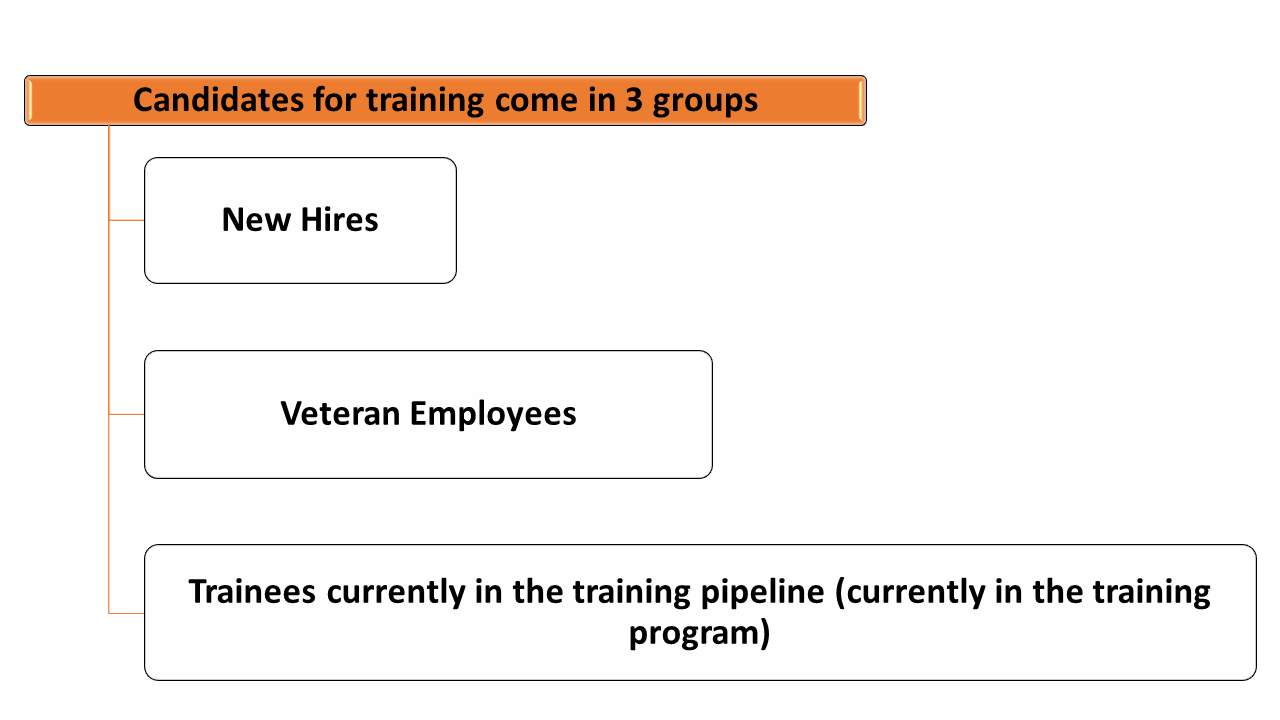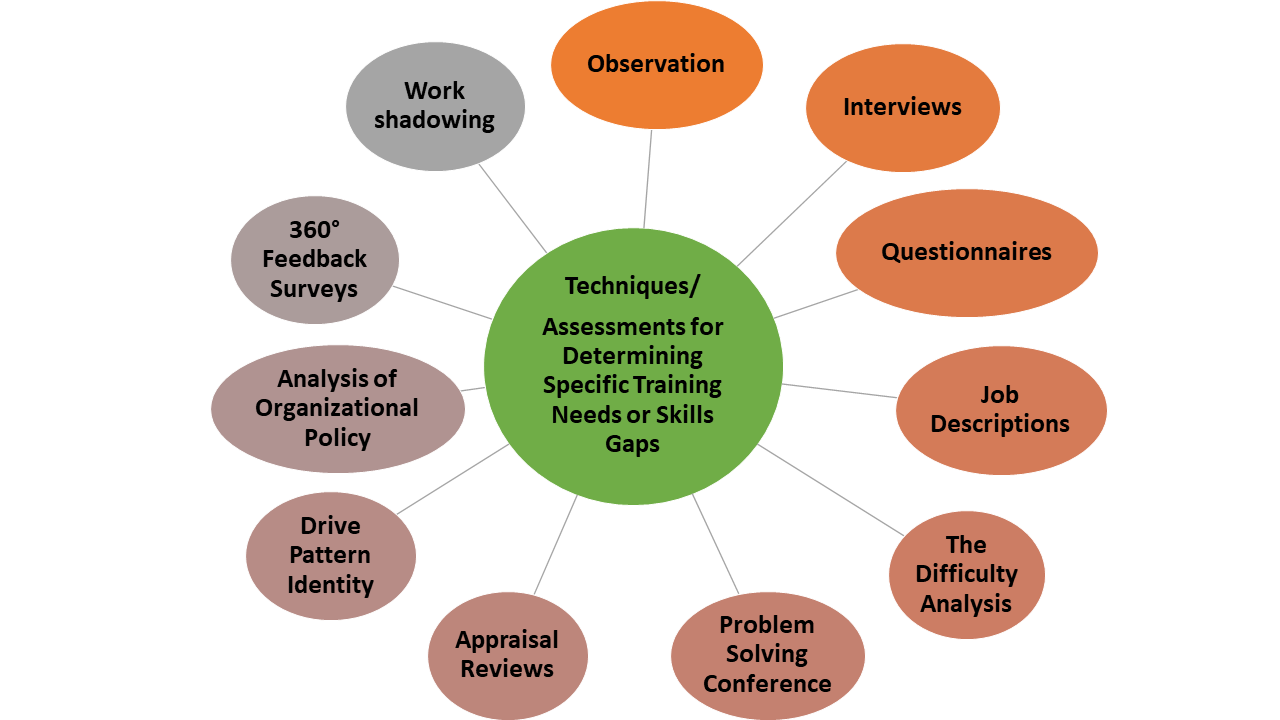
The training needs analysis process is a series of activities conducted to identify problems or other issues in the workplace and to determine whether training is an appropriate response.
The needs analysis is usually the first step taken to cause a change. This is mainly because a needs analysis specifically defines the gap between the current and the desired individual and organisational performances.
The Training Needs Analysis (TNA) is therefore an essential first step in management development.
If you wish to achieve the greatest improvement in performance and best value from your investment in training, development, practical experience or networking, you should first undertake a comprehensive training needs analysis. This will form the basis for designing a cost effective management or talent development programme.
In easier terms, training needs analysis means that you identify the training needs of the employees that will enable him/her to develop the skills that he/she needs to deliver according to his/her performance agreement.
Who Conducts Needs Analysis and Why?

An in-house employee (manager, trainer, etc.) or a consultant performs a needs analysis to collect and document information concerning any of the following three issues:
- Performance problems,
- Anticipated introduction of new system, task or technology, and
- A desire by the organisation to benefit from a perceived opportunity.
In all three situations the starting point is the desire to effect a change. Given this, you must know how the people will experience change, perceive it. In the absence of a needs analysis, you may find employees resistant to change and reluctant to training. They may be unable to transfer their newly acquired skills to their jobs because of the organizational constraints.
A needs analysis often reveals the need for well-targeted training areas. However, we must keep in mind that training is not always the best way to try to close a particular gap between an organization’s goals and its actual performance. Those conducting the needs analysis must get a clear idea of the problem, look at all possible remedies and report on their findings to management before deciding on the best solution.
When properly done, a needs analysis is a wise investment for the organization. It saves time, money and effort by working on the right problems. Organizations that fail to support needs analysis make costly mistakes; they use training when another method would have been more effective; they use too much or too little training,
A well-performed analysis provides the information that can lead to solutions that focus on the areas of greatest need.
Methods of Identifying Training Needs
Training needs will differ with the backgrounds of the employees to be trained, and their present status in the organization. Basically, a candidate for training may come from any one of three groups:

Consideration of the varying needs of these groups provides a frame of reference for discussing and suggesting the methods of identifying training needs:
New Hires
Addition of new employees creates high and low peaks in placing new persons into the training program. This problem may be solved by a program where progression is made in different sequences. It will eliminate a jam that will occur if all phases of the program must be taken in a definite sequence.
The new employees will normally be of somewhat different backgrounds. Being new, they are not familiar with their new employers. As a result, the earliest phases of the training must concentrate on company orientation. During these phases, the organisation, organisation policies and administrative details should be covered. It is also a suitable time to acquaint the trainees with what will be expected of him, and how he will be evaluated throughout the phase of training.
Retaining and Upgrading Veteran Employees
The people in this category offer a real challenge to the training department. Therefore, the number and amount of training required by this category should be carefully considered. Often the retraining and upgrading of former employees can be very rewarding for training instructors. At least two schools of thought exist as to how these employees should be rekindled. There are advantages in keeping this group intact and tailoring the program to their needs. On the other hand, this category of employees can also make significant contribution to training if they are co-mingled with the new hires.
Pipeline Employee Requirements
A good training program will normally have participants in various phases of completion. An awareness of completion dates and how the potential employee will be employed should be the concern of the training staff and also the employee’s supervisor. A trainee should have a challenge in all phases of his training. All these challenges should not be confined to those phases where the pipeline employee is sitting in a classroom. Therefore, it is recommended that thorough interim test-work be given to pipeline employees in periods between formal classes. This may take the form of solidifying what he learned in the prior phase and serve as preparation for the coming phases.

Techniques/Assessments for Determining Specific Training Needs or Skills Gaps
There are a number of practical methods you can use to gather data about employees’ performance. Each works well in given circumstances; therefore, you must determine which will be the best for you. None of these methods can stand alone. Always use at least two, if, for no other reason, to validate your findings. One of those you choose should always be observation.

Observation
In this approach, an employee’s performance itself is you source of information. You evaluate a worker’s performance through first-hand observation and analysis. This is best accomplished by watching the worker and playing the role of non-participating observer. This means that you watch and listen and evaluate what you see and hear, but do not get involved in his work process in any way.
To make this activity more productive, use a checklist to remind you of what to look for and take notes.
The objective during observations is to identify both the strengths to build on and the deficiencies to overcome. A key advantage of using direct observation in the needs analysis is that you gain first-hand knowledge and understanding of the job being performed and the strengths and weaknesses of the relevant worker.
Interviews
The use of interviews in conducting the needs analysis is strongly urged. The prime value of interview guides is that they ensure the same types of data from all sources. This allows you to determine whether a piece of information is one person’s opinion, or part of a widespread perception. Since the interview guide forces you to ask each worker a number of predetermined questions, you must select those questions that are essential to what you are trying to learn.
Interviews allow you to meet employees face to face to discuss their impressions of performance. Because you are in conversation with workers, you can explore their responses in depth. You can ask or clarification of comments and for examples of what they mean. In this way, you obtain a full understanding of their performance deficiencies.
You also gain these benefits through interviewing:
- You build credibility with your interviewees by asking intelligent questions and listening well to their answers.
- You obtain employees’ personal involvement and commitment to your efforts.
- You establish personal relationships with potential trainees who are important to your success as a needs analyst and trainer.
Questionnaires
A questionnaire is a sort of interview on paper. You create your own questionnaire by writing down all the questions you want employees to answer for you. Then you mail it to them or if not possible, have personal interviews for them to complete it. Then await their responses.
The key advantage of a questionnaire is that you can include every person from whom you want input. Employees can complete the questionnaire when and where they choose. You need not travel and spend time with all respondents. Every employee is asked the identical questions and consequently data is very easy to compile and analyse.
Questionnaires can be useful in obtaining a “big picture” of what a large number of employees think while allowing everyone to feel that they have had an opportunity to participate in the needs analysis process.
Job Descriptions
Before establishing a job description, a job analysis must be made. This job analysis involves a thorough study of all responsibilities of the relevant job. It is companywide in scope and should be detailed to such a degree that those conducting the training can use the job analysis as a yardstick for their course content. After the job analysis phase has been completed, the writing of job description and needs analysis is a relatively simple task. When an employee’s job description has been defined, the trainer can easily tailor his training curriculum to a very close proximity of what will be expected of the employees.
The Difficulty Analysis
The Job Analysis will focus attention on enumerating the numerous duties that a worker must perform. On the other hand, the Difficulty Analysis establishes which of the duties cause the employee the greatest amount of troubles and how this trouble can be reduced through better training.
A good Difficulty Analysis offers many advantages. For example:
- It enables a needs analyst to weigh certain aspects of the training in relationship to the expected difficulty that the worker will face in coping with those duties.
- A well thought out Difficulty Analysis will provide the training program with abundance of role-playing material and situations.
Problem Solving Conference
Another time-tested technique for gathering needs analysis material from employees is to conduct periodic problem-solving conferences which may take the form of or be part of a plan for a new product, task or technology, or tied in with a training program. It is always helpful to utilize an outside consultant to moderate such sessions. This outside sponsorship has a tendency of letting the workers express their feelings about his organization, and the session can then be geared to training needs. The current problems will evolve that represent potential areas for training.
Appraisal Reviews
During the periodic counselling performance interview, an employee should be questioned regarding the duties and training of a worker. Comments rendered during the appraisal interviews normally are genuine, and can frequently assist in establishing the needs, variations and penetrations that a training program should include. Feed- back at appraisal interview time is valuable since it is timely information. Training needs differ from worker to worker, and appraisal sessions allow the employee and supervisor/manager to uncover the cause of weaknesses in performance. These deficiencies represent areas for training.
Drive Pattern Identity
The extent of an employee’s development depends on his motivations. Identifying the forces that cause an employee to behave in a certain way may be useful in determining his individual training needs and how to stimulate his desire to fulfil that need. An analysis of this kind, for example, may determine that the employee has an urgent need for self-confidence. His individual program should be made to stress the importance of attitude, skills etc. and any other assets that would give him this self- confidence.
Analysis of Organizational Policy
Organization policy will affect the amount of training offered. An explanation of various policies should be covered in the training program. Of particular concern are those policies that involve change, alteration and major revamping of training programs. In organizations undergoing merger activity, product diversification and new penetration, a great deal of sensitivity must be placed on policies today and expected changes in the future.
360° Feedback Surveys
A 360° feedback survey helps the organisation obtain quality information about performance and relationships by posing a set of standard questions to an individual's line manager, peers and direct reports. This all around (360°) approach identifies any variation of behaviour in different roles and minimises personal bias. The information can be collected on paper forms or using computer systems; the print-out in either case acts as a third-party report which managers or coaches and their clients can discuss in a non-emotional manner.
Click here to view a video that explains what 360 degree feedback is.
It is recommended that a 360° survey should precede any developmental coaching programme. When reviewing an individual, it is often best to ask open questions such as:
Keep doing: What are the things that 'name' currently does which help you and which you hope he/she will continue to do?
Do more of: What are the things you would like 'name' to start doing or do more of?
Do less of: What are the things which 'name' does which get in the way and which you would like to be done less often?
Development needs: What are the areas upon which you feel 'name' should really concentrate in order to improve the managerial performance of the organisation? You may wish to highlight aspects of how he/she manages or specific objectives or accountabilities which you feel need attention.
Personal strengths: What do you see as the key strengths which 'name' brings to his/her job?
Work Shadowing
Work shadowing involves a coach spending time with an individual while he or she is carrying out their normal work. The coach sits in on meetings and observes the individual's behaviour in different circumstances. Feedback can then be immediate or compiled into a formal report. The instant feedback is a valuable part of the coaching process.
Problems and Barriers when Conducting a Needs Analysis
You could experience five problems or barriers that can arise when conducting a needs assessment. Before conducting an assessment, plan how to deal with or avoid these five issues:
Confidential information: Tell those who offer information during the assessment whether the information they offer is confidential or anonymous. Either do not ask for the name of the person completing the survey or questionnaire or offer the option to provide a name. Generally, respondents are more forthcoming if they can remain anonymous. Be sure to clarify concerns about how interview or survey information will be used.
Management buy-in: Management needs to be involved in all three phases of the needs assessment. Sell the purpose and benefits of the survey or interviews to all the managers who are involved with the deficiency prior to collecting information. Tie the survey data to the strategic plan and/or performance review processes.
Unwilling employees are participants: Employees may not be willing to spend a lot of time to complete a survey or an interview. To increase participation in information gathering, have a top executive send a cover letter with the survey or, prior to an interview, ask for the employee’s cooperation in completing the survey or giving the interview. Get key employees to be goodwill ambassadors for the process. Make the distribution, the completion and the return of the survey or the conducting of the interview as convenient as possible.
Cost: During the needs assessment, the performance deficiency usually continues. Promote the gathering of information as an investment in the progress of the organization. Do a feasibility study on the savings from conducting the survey or interviews or just doing nothing. Often commonly held assumptions can be validated or changed when hard data is gathered. Use existing data regarding the deficiency to avoid the cost of asking for what is already available.
Interrupts work: Time is money. Taking away employees from productive work to complete a survey or an interview may detract from work results. Keep the survey brief, streamlined and attractive in appearance. When conducting interviews, write out key questions prior to the interview. Set specific appointments with a starting and ending time.
Click here to download an example of the Training Needs Analysis questionnaire for employees
Click here to download an example of a summary report of the training needs analysis.